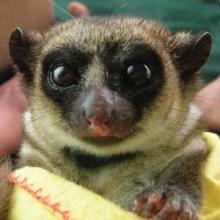This species was long known only from museum specimens collected from three localities in Madagascar’s Central Domain (Groves, 2000). The type locality, Ankeramadinika, a “day’s journey east of Antananarivo” (Groves, 2000), is just east of the Mangoro River, 1,408 m above sea level (Blanco et al., 2009; Groeneveld et al., 2010). Blanco et al. (2009) recorded sympatric dwarf lemurs about 100 km south of Ankeramadinika, in the mid- and high-altitude forests of the Tsinjoarivo region, a forest block isolated by two rivers (the Onive in the south and the Mangoro in the east) and bounded by the high-altitude central plateau in the west. They identified C. crossleyi in extensive forest at a site called Vatateza at about 1,390 m above sea level, and (tentatively at the time) C. sibreei, in a forest patch of 228 km2 at Andasivodihazo at about 1,660 m above sea level. Blanco et al. (2009) based their identifications on morphometric traits. Subsequent molecular genetic studies by Groeneveld et al. (2010) confirmed their conclusion: “the individuals from Andasivodihazo are distinct from C. medius, C. major and C. crossleyi and thus represent a fourth species” (p.10). Groeneveld et al. (in press) carried out further morphometric analyses of the Andasivodihazo dwarf lemurs, comparing them with the C. sibreei holotype in the British Museum, and concluded that they were indeed the same species.
As reported by Groeneveld et al. (2010), three localities were sampled at Tsinjoarivo on two occasions between 2006 and 2009. Cheirogaleus crossleyi was subsequently also found at Andasivodihazo, and C. sibreei alone was recorded at a nearby site called Ankadivory at about 1,470 m above sea level. They indicated that C. sibreei may be restricted by the Onive and Mangoro rivers, Anjozorobe, and the corridor to the western half of the Tsinjoarivo forest above 1,400 m altitude, in an area of less than 2,000 km2. Rasolofoson et al. (2007a, 2007b) reported it far to the north, in the Makira Forest. It seems that this locality is a rather large range extension, and it may be that a closely related species, thus far undescribed, is involved (C. P. Groves, pers. comm.). Groeneveld et al. (2010) determined that the Naturalis material from Pasandava Bay examined by Groves (2000), was aligned, morphometrically and genetically, with C. medius, not C. sibreei.
